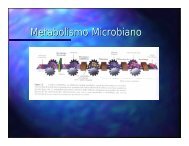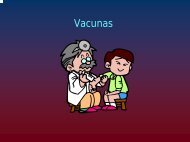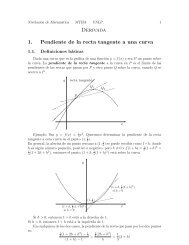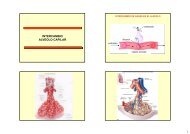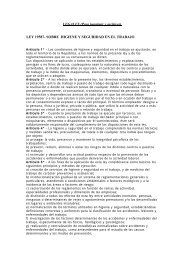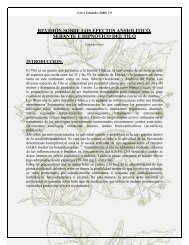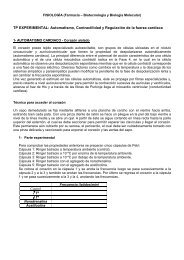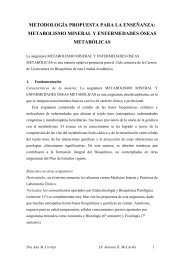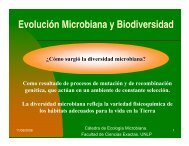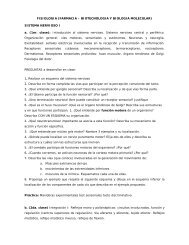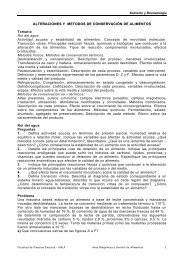Epigenetic aspects of somaclonal variation in plants
Epigenetic aspects of somaclonal variation in plants
Epigenetic aspects of somaclonal variation in plants
You also want an ePaper? Increase the reach of your titles
YUMPU automatically turns print PDFs into web optimized ePapers that Google loves.
Plant Molecular Biology 43: 179–188, 2000.M.A. Matzke and A.J.M. Matzke (Eds.), Plant Gene Silenc<strong>in</strong>g.© 2000 Kluwer Academic Publishers. Pr<strong>in</strong>ted <strong>in</strong> the Netherlands.179<strong>Epigenetic</strong> <strong>aspects</strong> <strong>of</strong> <strong>somaclonal</strong> <strong>variation</strong> <strong>in</strong> <strong>plants</strong>Shawn M. Kaeppler ∗ , Heidi F. Kaeppler and Yong RheeDepartment <strong>of</strong> Agronomy, University <strong>of</strong> Wiscons<strong>in</strong>-Madison, 1575 L<strong>in</strong>den Drive, Madison, WI 53706, USA( ∗ author for correspondence; e-mail: smkaeppl@facstaff.wisc.edu)Key words: DNA methylation, mutagenesis, <strong>somaclonal</strong> <strong>variation</strong>, tissue cultureAbstractSomaclonal <strong>variation</strong> is manifested as cytological abnormalities, frequent qualitative and quantitative phenotypicmutation, sequence change, and gene activation and silenc<strong>in</strong>g. Activation <strong>of</strong> quiescent transposable elementsand retrotransposons <strong>in</strong>dicate that epigenetic changes occur through the culture process. <strong>Epigenetic</strong> activation<strong>of</strong> DNA elements further suggests that epigenetic changes may also be <strong>in</strong>volved <strong>in</strong> cytogenetic <strong>in</strong>stability throughmodification <strong>of</strong> heterochromat<strong>in</strong>, and as a basis <strong>of</strong> phenotypic <strong>variation</strong> through the modulation <strong>of</strong> gene function.The observation that DNA methylation patterns are highly variable among regenerated <strong>plants</strong> and their progenyprovides evidence that DNA modifications are less stable <strong>in</strong> culture than <strong>in</strong> seed-grown <strong>plants</strong>. Future researchwill determ<strong>in</strong>e the relative importance <strong>of</strong> epigenetic versus sequence or chromosome <strong>variation</strong> <strong>in</strong> condition<strong>in</strong>g<strong>somaclonal</strong> <strong>variation</strong> <strong>in</strong> <strong>plants</strong>.IntroductionVariation <strong>in</strong> plant phenotype is determ<strong>in</strong>ed by geneticand epigenetic factors. Phenotypic and DNA <strong>variation</strong>among putative plant clones is termed <strong>somaclonal</strong><strong>variation</strong>. The purpose <strong>of</strong> this review is to describeevidence <strong>in</strong>dicat<strong>in</strong>g that epigenetic <strong>variation</strong> is an importantmechanistic basis <strong>of</strong> <strong>somaclonal</strong> <strong>variation</strong> <strong>in</strong><strong>plants</strong>.Somaclonal <strong>variation</strong> is def<strong>in</strong>ed as genetic and phenotypic<strong>variation</strong> among clonally propagated <strong>plants</strong> <strong>of</strong>a s<strong>in</strong>gle donor clone (reviewed <strong>in</strong> Sunderland, 1973;D’Amato, 1977, 1985; Bayliss, 1980; Lark<strong>in</strong> andScowcr<strong>of</strong>t, 1981, 1983; Orton, 1984; Ahloowahlia,1986; Lark<strong>in</strong>, 1987; Lee and Phillips, 1988; Sunand Zheng, 1990; Peschke and Phillips, 1992; Kaepplerand Phillips, 1993a; Duncan, 1997; Kaeppleret al., 1998; Veilleux and Johnson, 1998; Olh<strong>of</strong>tand Phillips, 1999). Somaclonal <strong>variation</strong> caused bythe process <strong>of</strong> tissue culture is also called tissueculture-<strong>in</strong>duced <strong>variation</strong> to more specifically def<strong>in</strong>ethe <strong>in</strong>duc<strong>in</strong>g environment. Somaclonal <strong>variation</strong> canbe manifested as either somatically or meioticallystable events. Somatically stable <strong>variation</strong> <strong>in</strong>cludesphenotypes such as habituation <strong>of</strong> cultures and physiologically<strong>in</strong>duced <strong>variation</strong> observed among primaryregenerants. This type <strong>of</strong> <strong>variation</strong> is <strong>of</strong>ten not transmittedto subsequent generations and is <strong>of</strong> most impact<strong>in</strong> situations where the primary regenerant is the endproduct such as the amplification <strong>of</strong> ornamental <strong>plants</strong>or trees for direct use. Meiotically heritable <strong>variation</strong>also occurs and is important <strong>in</strong> situations where theend product <strong>of</strong> the tissue culture is propagated andsold as seed. Mechanisms produc<strong>in</strong>g both somaticallyand meiotically heritable <strong>variation</strong> also contribute tothe decl<strong>in</strong>e <strong>in</strong> vigor and regenerability <strong>of</strong> cultures overtime. The loss <strong>of</strong> culture health with time is a majordetriment to the efficiency <strong>of</strong> transgenic plant productionand much effort has been devoted to avoid<strong>in</strong>g thisproblem.<strong>Epigenetic</strong> control <strong>of</strong> gene expression can be def<strong>in</strong>edas a somatically or meiotically heritable alteration<strong>in</strong> gene expression that is potentially reversibleand is not due to sequence modification. <strong>Epigenetic</strong> <strong>aspects</strong><strong>of</strong> <strong>somaclonal</strong> <strong>variation</strong> would therefore <strong>in</strong>volvemechanisms <strong>of</strong> gene silenc<strong>in</strong>g or gene activation thatwere not due to chromosomal aberrations or sequencechange. These changes might be unstable or reversiblesomatically or through meiosis, although certa<strong>in</strong> epigeneticsystems outside <strong>of</strong> tissue culture are quite[59]
180stable for many generations (Patterson et al., 1993;Cubas et al., 1999). Therefore, epigenetic changes<strong>in</strong>duced by tissue culture could be manifested as theactivation <strong>of</strong> quiescent loci or as epimutation <strong>of</strong> locisensitive to chromat<strong>in</strong>-level control <strong>of</strong> expression.Somaclonal <strong>variation</strong> is manifested as quantitativeand qualitative trait mutation, karyotype changes,and sequence modificationSomaclonal mutant phenotypes segregate asqualitatively and quantitatively <strong>in</strong>herited mutationsSomaclonal <strong>variation</strong> was first detected by the highfrequency <strong>of</strong> qualitatively segregat<strong>in</strong>g phenotypes observedamong progeny <strong>of</strong> <strong>plants</strong> that were expected tobe genetically identical (reviewed <strong>in</strong> Lark<strong>in</strong> and Scowcr<strong>of</strong>t,1981, 1983; Orton, 1984; Ahloowahlia, 1986;Lark<strong>in</strong>, 1987; Sun and Zheng, 1990; Peschke andPhillips, 1992; Kaeppler and Phillips, 1993a). Thiswas especially true <strong>in</strong> diploid species such as maizewhere mutations could be easily observed and werenot obscured by genetic buffer<strong>in</strong>g that is prevalent<strong>in</strong> polyploid species. For example, a study <strong>of</strong> maizegrown for 8 months <strong>in</strong> culture found that, on average,every regenerated plant conta<strong>in</strong>ed 1.32 mutantsthat produced a visible phenotype (Lee and Phillips,1987b). These qualitative mutants were stably <strong>in</strong>heritedfor several subsequent seed-derived generations.Detailed phenotypic analyses <strong>in</strong> later studiesshowed that quantitative <strong>variation</strong> is also frequentlyfound among regenerant-derived progeny (reviewed <strong>in</strong>Duncan, 1997; Veilleux and Johnson, 1998). Quantitative<strong>variation</strong> has been described for many phenotypes<strong>in</strong>clud<strong>in</strong>g plant height, plant biomass, gra<strong>in</strong> yield, andagronomic performance (e.g. Earle and Gracen, 1985;Zehr et al., 1987; Lee et al., 1988; Carver and Johnson,1989; Dahleen et al., 1991; Bregitzer et al.,1998). A generalization <strong>of</strong> studies that have assessedquantitative <strong>variation</strong> is that quantitative <strong>variation</strong> isfrequent and <strong>in</strong>heritance studies <strong>in</strong>dicate alteration <strong>of</strong>numerous loci.Tissue culture <strong>variation</strong> has also been harnessed<strong>in</strong> some cases to confer desirable traits to cultivars<strong>in</strong>clud<strong>in</strong>g desirable morphological traits, disease resistance,<strong>in</strong>sect resistance, acid tolerance, and salt tolerance(Duncan, 1997; Veilleux and Johnson, 1998).While there are a few examples <strong>of</strong> variants that areunstable such as the variegated Empress tree variety‘Somaclonal Snowstorm’ (Marcotrigiano and Jagannathan,1988) and an unstable flower color mutant <strong>of</strong>alfalfa (Groose and B<strong>in</strong>gham, 1986), the general lessonfrom the analysis <strong>of</strong> phenotypic <strong>variation</strong> acrossspecies is that mutation is frequent and <strong>of</strong>ten <strong>in</strong>heritedstably through sexual generations.Cytogenetic abnormalities and specific sequencechanges are frequently found <strong>in</strong> regenerated <strong>plants</strong>and their progenyChromosome-level mutationsChromosomal and sequence changes are prevalent<strong>in</strong> culture, consistent with the high frequency <strong>of</strong>observed phenotypic <strong>variation</strong>. Cytogenetic abnormalities<strong>in</strong>clud<strong>in</strong>g ploidy changes and chromosomerearrangements have been found among tissue cultureregenerants. Hang and Bregitzer (1993) foundploidy changes to be the most prevalent cytologicalchange among barley regenerants, although chromosomebreakage events also occurred. A comparativeanalysis <strong>in</strong> oat and maize showed that chromosomebreakage occurred more frequently than ploidychanges (reviewed <strong>in</strong> Benzion et al., 1986; Kaeppleret al., 1998). Translocations were the most frequentchromosomal abnormality observed with <strong>in</strong>versionsand <strong>in</strong>sertions/deletions also occurr<strong>in</strong>g. The fact thatmost breakages were either between heterochromaticknobs and the centromere <strong>in</strong> maize, or with<strong>in</strong> thecentromeric heterochromat<strong>in</strong> <strong>in</strong> oat, led to the hypothesisthat replication <strong>of</strong> heterochromat<strong>in</strong> occurred late<strong>in</strong> tissue culture lead<strong>in</strong>g to chromosome bridges andbreakage events (Johnson et al., 1987). Chromosomebreakage events also <strong>in</strong>volved heterochromat<strong>in</strong> <strong>in</strong> theHang and Bregitzer (1993) study on barley, furthersupport<strong>in</strong>g this hypothesis.Sequence <strong>variation</strong>Sequence <strong>variation</strong> aris<strong>in</strong>g through the culture processhas been detected <strong>in</strong> several different ways (reviewed<strong>in</strong> Kaeppler et al., 1998; Olh<strong>of</strong>t and Phillips, 1999)<strong>in</strong>clud<strong>in</strong>g random genome scann<strong>in</strong>g us<strong>in</strong>g RFLPs orRAPDs, and analysis <strong>of</strong> specific mutants. Variant storageprote<strong>in</strong> or isozyme electrophoresis pr<strong>of</strong>iles suggestsequence change occurs much more frequently thangene deletion s<strong>in</strong>ce migration pr<strong>of</strong>iles are altered, butnull alleles are rare. A direct l<strong>in</strong>k between variantprote<strong>in</strong> and DNA sequence change has only been establishedfor two events (Brettell et al., 1986; Denniset al., 1987). In these studies, tissue culture-derivedmutant Adh1 alleles were found to be due to two <strong>in</strong>dependentpo<strong>in</strong>t mutations, both A-to-T transversions.[60]
181Methylation pattern <strong>in</strong>stabilityDNA methylation <strong>variation</strong> has been hypothesizedas an underly<strong>in</strong>g mechanism <strong>of</strong> tissue culture<strong>in</strong>ducedmutagenesis due to the high frequency<strong>of</strong> quantitative phenotypic <strong>variation</strong>, the activation<strong>of</strong> transposable elements, heterochromat<strong>in</strong>-<strong>in</strong>ducedchromosome-breakage events, and the high frequency<strong>of</strong> sequence change. Phillips et al. (1994) proposedthat DNA methylation <strong>variation</strong> conditions chromat<strong>in</strong>changes which ultimately cause quantitative <strong>variation</strong>by modulat<strong>in</strong>g the effects <strong>of</strong> multiple loci, chromosomebreakage by alter<strong>in</strong>g tim<strong>in</strong>g <strong>of</strong> replication, andbase changes through a process similar to RIP <strong>in</strong>fungi (Selker and Stevens, 1985). While none <strong>of</strong> thehypothesized effects <strong>of</strong> DNA methylation change ontissue culture <strong>variation</strong> have been confirmed, DNAmethylation patterns have been shown to vary amongregenerated <strong>plants</strong> and their progeny <strong>in</strong> a number <strong>of</strong>studies.Methylation patterns were first reported to varyamong regenerated <strong>plants</strong> and their progeny <strong>in</strong> rice(Brown et al., 1990) and maize (Brown et al.,1991). Kaeppler et al. (1993b) reported that DNAmethylation patterns varied substantially among maizeregenerant-derived families from the same culturedexplant, with all families hav<strong>in</strong>g unique methylationpr<strong>of</strong>iles across 20 s<strong>in</strong>gle-copy probes. In this study, asignificant frequency <strong>of</strong> the methylation changes didnot segregate among R 1 progeny, <strong>in</strong>dicat<strong>in</strong>g that thechanges were homozygous <strong>in</strong> the primary regenerant.In addition, hypomethylation was much more frequentthan hypermethylation. Olh<strong>of</strong>t (1996) conducteda more extensive analysis <strong>of</strong> methylation <strong>variation</strong>among regenerant-derived progeny us<strong>in</strong>g 206 s<strong>in</strong>glecopyprobes. This work corroborated the observationthat the majority <strong>of</strong> methylation changes are decreases,with decreases <strong>in</strong> methylation occurr<strong>in</strong>g three timesas frequently as <strong>in</strong>creases. Quantification <strong>of</strong> globalmethylation levels on these same <strong>plants</strong> <strong>in</strong>dicated asignificant <strong>in</strong>crease <strong>in</strong> methylation overall. It is notknown if the overall <strong>in</strong>crease <strong>in</strong> methylation was dueto <strong>in</strong>creased methylation <strong>of</strong> repeated sequences or toanother mechanism such as genome expansion due togene amplification or retrotransposon activity.Global methylation changes have also been studied<strong>in</strong> tissue culture. LoSchiavo et al. (1989) showedthat global methylation levels changed <strong>in</strong> responseto hormone concentration <strong>in</strong> the media <strong>of</strong> carrot cultures.Methylation levels decreased with <strong>in</strong>creas<strong>in</strong>gconcentration <strong>of</strong> k<strong>in</strong>et<strong>in</strong>, but <strong>in</strong>creased with <strong>in</strong>creas<strong>in</strong>gamounts <strong>of</strong> the aux<strong>in</strong> 2,4-D. In this study, methylationlevels were also developmentally regulated,be<strong>in</strong>g ‘reset’ as cells were <strong>in</strong>duced to embryogenesis.Arnholt-Schmitt et al. (1995) also reported thatglobal methylation levels <strong>of</strong> carrot culture changed<strong>in</strong> a growth-phase-dependent manner. A companionstudy (Arnholt-Schmitt, 1995) found that the copynumber <strong>of</strong> repeated sequences also changed throughdevelopment, concurrent with the methylation change.Therefore, the comb<strong>in</strong>ed data suggest that methylationreduction may have occurred due to genomedim<strong>in</strong>ution rather than changes <strong>in</strong> the frequency <strong>of</strong>methylated target sites.Studies <strong>of</strong> both global methylation levels andmethylation <strong>of</strong> specific sites show that <strong>variation</strong> <strong>in</strong>DNA methylation occurs frequently <strong>in</strong> the cultureprocess. Global methylation studies support the ideathat developmental tim<strong>in</strong>g may play a role <strong>in</strong> effect<strong>in</strong>g<strong>variation</strong> <strong>in</strong> methylation levels and patterns.Transposon activation and some examples <strong>of</strong> genesilenc<strong>in</strong>g <strong>in</strong>dicate that epigenetic mechanismscontribute to the process <strong>of</strong> <strong>somaclonal</strong> <strong>variation</strong>The observation <strong>of</strong> chromosome breakage events <strong>in</strong>culture supports the contention that tissue culture <strong>in</strong>ducesa genomic shock. Genomic shock has beenshown to activate transposable elements <strong>in</strong> other systems(McCl<strong>in</strong>tock, 1984), so it was not unexpectedthat Ac (Peschke et al., 1987) and Spm/En (Peschkeand Phillips, 1991) activity was detected amongregenerant-derived progeny. The frequency <strong>of</strong> <strong>in</strong>dependentregenerants with active elements is quite low,but these studies clearly show that element activationoccurs through the culture process.Hirochika et al. (1996) showed that retrotransposonsalso have enhanced transcription <strong>in</strong> culture.Retrotransposons are another class <strong>of</strong> DNA elementsthat are generally quiescent <strong>in</strong> the genomes <strong>of</strong> <strong>plants</strong>.In the Hirochika et al. (1996) study, three rice retrotransposonfamilies (Tos10, Tos17, and Tos19)had<strong>in</strong>creased transcription rates as cell cultures aged. Sequenceanalysis <strong>of</strong> flank<strong>in</strong>g sequences <strong>in</strong>dicated thatretrotransposon <strong>in</strong>tegration occurred <strong>in</strong>to genic regions.No phenotype was specifically correlated withthe <strong>in</strong>sertion events.Quiescent transposons and retrotransposons exist<strong>in</strong> the genomes <strong>of</strong> many plant species, and theiractivation <strong>in</strong> tissue culture supports the notion thatderepression <strong>of</strong> epigenetically silenced sequences is<strong>in</strong>duced by the culture process. Several <strong>in</strong>terest<strong>in</strong>gobservations were made dur<strong>in</strong>g the study <strong>of</strong> transpos-[61]
182able elements <strong>in</strong> culture. Brettell and Dennis (1991)showed that a recently <strong>in</strong>activated Ac element was reactivatedat a high frequency <strong>in</strong> culture, a frequencymuch higher than observed <strong>in</strong> seed-derived <strong>plants</strong>. Reactivationwas correlated with reduced methylation.This result <strong>in</strong>dicated that tissue culture does destabilizeepigenetically silenced events, and suggests thatrecently silenced elements can be activated more easilythan other quiescent elements <strong>in</strong> the genome. Molecularanalysis <strong>of</strong> activated Ac elements by Peschkeet al. (1991) found that there was not an exact correlationbetween activity and methylation state. Therefore,reduction <strong>in</strong> DNA methylation may not be responsiblefor the activation, but may occur over time keep<strong>in</strong>gelements <strong>in</strong> an active, or easily ‘activatable’, state. Interest<strong>in</strong>gly,none <strong>of</strong> the maize regenerant-derived l<strong>in</strong>eswith transposable element activity had cytogenetic abnormalitiesthat would have supported a chromosomebreakage event occurr<strong>in</strong>g <strong>in</strong> their l<strong>in</strong>eage. Therefore,the genomic shock <strong>in</strong>duced by culture may not be <strong>in</strong>itiatedby chromosome breakage. Rather the <strong>in</strong>stability<strong>of</strong> repeated sequences and the late replication <strong>of</strong> heterochromat<strong>in</strong>may be due to genome stresses whichalso activate elements.Another <strong>in</strong>trigu<strong>in</strong>g mutant putatively result<strong>in</strong>gfrom epigenetic silenc<strong>in</strong>g is a dwarf mutant <strong>in</strong> riceidentified by Oono (1985). This mutant was firstobserved as a ‘homozygote’ <strong>in</strong> the primary regenerantand could be ma<strong>in</strong>ta<strong>in</strong>ed through sexual selfgenerations.However, the mutant showed a lowfrequency <strong>of</strong> reversion and could not be ma<strong>in</strong>ta<strong>in</strong>ed<strong>in</strong> crosses <strong>of</strong> the regenerant-derived progenyto uncultured <strong>plants</strong>. Interest<strong>in</strong>gly, treatment <strong>of</strong>dwarf types with the DNA methylation <strong>in</strong>hibitor 5-deoxyazacytid<strong>in</strong>e resulted <strong>in</strong> the restoration <strong>of</strong> the normalphenotype. This result further <strong>in</strong>dicated that thedwarf mutant was the result <strong>of</strong> a reversible, epigeneticsilenc<strong>in</strong>g event.These examples <strong>in</strong>dicate that epigenetic repressionand derepression does occur dur<strong>in</strong>g the tissue cultureprocess. To date, there has not been a mutant phenotypereported, outside <strong>of</strong> transposable elements, wherethe basis <strong>of</strong> the mutation was shown to be epigeneticby both genetic and molecular analysis.An example <strong>in</strong> maize <strong>of</strong> a locus potentially sensitive tosilenc<strong>in</strong>g <strong>in</strong>duced by the culture processWe have recently analyzed a series <strong>of</strong> white cob mutants<strong>in</strong> maize and have evidence to suggest that genesilenc<strong>in</strong>g may be responsible for a mutant phenotype<strong>in</strong> these l<strong>in</strong>es. The genetic pathway condition<strong>in</strong>g cobcolor <strong>in</strong> maize is well def<strong>in</strong>ed and the genes <strong>in</strong> thepathway have been cloned. The p locus is the transcriptionfactor that activates the pigment pathway,and the genotype used as an explant source conta<strong>in</strong>edthe P-wr allele at this locus. The P-wr allele conditionsred pigmentation <strong>of</strong> the glumes <strong>of</strong> the cob, butnot the pericarp, and is a complex locus with sevenrepeats (Chopra et al., 1996). The P locus activatesthree metabolic genes, a1, c2, and chi, which metabolizea red phlobaphene pigment. The a1, c2, andchi loci are s<strong>in</strong>gle-copy genes, although there are noncomplement<strong>in</strong>gorthologues at homeologous positions<strong>in</strong> the genome. The tissue culture-<strong>in</strong>duced mutantsunder analysis were all identified among progeny <strong>of</strong>B73Ht or LH51 <strong>plants</strong> regenerated after 3 to 5 months<strong>in</strong> culture.The first <strong>in</strong>trigu<strong>in</strong>g result <strong>in</strong> this study was thatcomplementation analysis <strong>in</strong>dicated that six <strong>of</strong> then<strong>in</strong>e white cob mutants were allelic to p. One <strong>of</strong> themutants was allelic to c2 and the other two were notallelic to p, c2, or a1. A chi tester stock was notavailable. This result is <strong>in</strong>trigu<strong>in</strong>g because <strong>of</strong> the preponderance<strong>of</strong> mutations at the p locus. The P-wrallele has a lower than average mutation frequency <strong>in</strong>most mutagenesis experiments, a fact attributed to thelikely expression <strong>of</strong> more than one <strong>of</strong> the copies <strong>of</strong> thiscomplex locus. Therefore, the frequency <strong>of</strong> p mutantsis expected to be less than 1 out <strong>of</strong> 4, and certa<strong>in</strong>lynot the predom<strong>in</strong>ant type. This led to the conclusionthat the p locus was more sensitive than the enzymaticloci to some type <strong>of</strong> tissue culture-<strong>in</strong>duced mutagenicprocess.The second <strong>in</strong>trigu<strong>in</strong>g result was the molecularanalysis <strong>of</strong> the mutants. None <strong>of</strong> the mutants withknown complementation had large deletions as resolvedus<strong>in</strong>g restriction enzyme analysis. Therefore,the observed mutations could not be expla<strong>in</strong>ed bymechanisms such as localized transposition or <strong>in</strong>tragenicrecomb<strong>in</strong>ation. However, Southern analysiswith methylation-sensitive restriction enzymes <strong>in</strong>dicatedthat the p locus had substantial hypermethylationacross the complex <strong>in</strong> the six p mutants, but not <strong>in</strong>the other mutants (Figure 1). No apparent methylationchange was observed <strong>in</strong> the c2 mutant whenprobed with sequences from that locus. Therefore,these results suggest the possibility that mutants at thep locus were unexpectedly frequent due to sensitivityto epigenetic silenc<strong>in</strong>g.We are currently explor<strong>in</strong>g whether epigenetic silenc<strong>in</strong>gis the molecular basis <strong>of</strong> the P mutants or if[62]
183Figure 1. DNA <strong>of</strong> tissue culture-<strong>in</strong>duced, white-cob mutant and non-cultured control <strong>plants</strong> restricted with the methylation-sensitive restrictionenzymes HpaII (A) and HhaI (B) and probed with a sequence specific to the P locus. Lanes 1–3 are <strong>in</strong>dependent white cob mutants allelic to P,lanes 4 and 6 are white cob mutants not allelic to P, and lanes 5 and 7 are the uncultured control. Methylation at the P locus is <strong>in</strong>creased <strong>in</strong> themutants allelic to P, but not <strong>in</strong> the other genotypes, relative to the uncultured control.hypermethylation occurred subsequent to a differentmutagenic event. However, these results <strong>in</strong>dicate thatepigenetic silenc<strong>in</strong>g may be responsible for six <strong>in</strong>dependenttissue culture-<strong>in</strong>duced mutants <strong>in</strong> maize. Ifso, this result raises the question <strong>of</strong> why the P locusis apparently more sensitive to modification thanother genes. Certa<strong>in</strong> p alleles have been shown to besubject to epigenetic control (Lund et al., 1995), soit is possible that this locus is <strong>in</strong>herently more sensitiveto epigenetic control and that tissue culture causesan <strong>in</strong>creased level <strong>of</strong> epigenetic change at this locus.Note that the methylation change <strong>in</strong> the p mutants ishypermethylation whereas s<strong>in</strong>gle-copy sequences <strong>in</strong>regenerant-derived <strong>plants</strong> generally show hypomethylation.Another <strong>in</strong>trigu<strong>in</strong>g aspect <strong>of</strong> the P-wr alleleis its repeated structure. Repeats have been shownto trigger methylation change <strong>in</strong> several systems (reviewed<strong>in</strong> Wolffe and Matzke, 1999), so it is possiblethat the repeated structure <strong>of</strong> the P-wr allele triggersepigenetic silenc<strong>in</strong>g. Further analysis <strong>of</strong> these particularmutants should allow us to determ<strong>in</strong>e if epigeneticsilenc<strong>in</strong>g is the molecular basis <strong>of</strong> the mutant phenotype.However, additional studies will be necessary todeterm<strong>in</strong>e if endogenous repeats are <strong>in</strong>herently lessstable <strong>in</strong> culture, and if genes subject to epigeneticcontrol outside <strong>of</strong> culture are more likely to be mutated<strong>in</strong> culture.How important are epigenetic mechanisms as abasis <strong>of</strong> <strong>somaclonal</strong> <strong>variation</strong>? Models andspeculationPlant regeneration bypasses the normaldevelopmental process <strong>of</strong> fertilization and plantdevelopment potentially result<strong>in</strong>g <strong>in</strong> <strong>in</strong>stability <strong>of</strong>epigenetic patternsTissue cultures are <strong>in</strong>itiated from a number <strong>of</strong> differentexplant sources, many <strong>of</strong> which (such as leaf blades)are highly differentiated. Cells from these ex<strong>plants</strong>dedifferentiate result<strong>in</strong>g <strong>in</strong> totipotent cultures fromwhich <strong>plants</strong> can be regenerated. S<strong>in</strong>ce the process<strong>of</strong> dedifferentiation and regeneration bypasses thenormal fertilization and development events <strong>of</strong> seedgrown<strong>plants</strong>, it is possible that the normal epigeneticprogram is not established <strong>in</strong> regenerated <strong>plants</strong>. Impr<strong>in</strong>t<strong>in</strong>gis thought to occur primarily <strong>in</strong> the endospermand not <strong>in</strong> diploid somatic tissue (Mess<strong>in</strong>g and Grossniklaus,1999), so impr<strong>in</strong>ted genes may not be a targetfor <strong>variation</strong>. However, epigenetic mechanisms arelikely <strong>in</strong>volved <strong>in</strong> the process <strong>of</strong> plant development(Richards, 1997), and parts <strong>of</strong> the process <strong>of</strong> pattern<strong>in</strong>gmay be bypassed <strong>in</strong> the regeneration process.Primary regenerants (R 0 ) are <strong>of</strong>ten more variable thantheir progeny. Examples <strong>of</strong> aberrant phenotypes <strong>in</strong> regenerated<strong>plants</strong> <strong>in</strong>clude abnormal leaf structures andvariant floral morphology. One example <strong>of</strong> a variantphenotype is the observation that many primarymaize regenerants have seed development on the tassel.These types <strong>of</strong> developmental abnormalities <strong>in</strong>the primary regenerants support the notion that developmentalpatterns are less tightly followed <strong>in</strong> plant[63]
184regeneration. The deviation from the normal developmentalpattern may be important for totipotency,but may also cause phenotypic <strong>variation</strong> which is notmeiotically heritable.If epigenetic patterns are part <strong>of</strong> the normal pattern<strong>of</strong> development, then certa<strong>in</strong> ex<strong>plants</strong> which havereached an advanced stage <strong>of</strong> development producecallus represent<strong>in</strong>g cells with different epigenetic patterns.Studies <strong>of</strong> qualitative mutations from tissueculture <strong>in</strong>dicate that mutations accumulate sequentiallywith time <strong>in</strong> culture (Fukui, 1983; Zehr et al.,1987). For example, <strong>plants</strong> regenerated from a threemonthold culture may conta<strong>in</strong> a dwarf mutation, and asubset <strong>of</strong> <strong>plants</strong> regenerated from the same culture aftersix months conta<strong>in</strong> both the dwarf mutation and anadditional mutation such as leaf stripes. Sequential accumulation<strong>of</strong> mutations over time provides evidencethat mutations are occurr<strong>in</strong>g dur<strong>in</strong>g the culture processand not pre-exist<strong>in</strong>g <strong>in</strong> the explant.However, Matzke and Matzke (1996) provide evidencethat pre-exist<strong>in</strong>g <strong>variation</strong> <strong>in</strong> the explant shouldnot be overlooked, especially <strong>in</strong> the case <strong>of</strong> epimutations.In this study, the authors implemented asequential transgenic strategy us<strong>in</strong>g hygromyc<strong>in</strong> resistanceand kanamyc<strong>in</strong> resistance markers to show thatdifferent epigenetic states <strong>of</strong> expression could be obta<strong>in</strong>edfrom regenerated <strong>plants</strong> from the same explant.Specifically, leaves <strong>of</strong> Hyg R transgenics conta<strong>in</strong>edmosaic sectors for Hyg R expression. Culture <strong>of</strong> leafsectors from these Hyg R <strong>plants</strong>, followed by a secondarytransformation with selection for kanamyc<strong>in</strong>resistance to generate cultures derived from s<strong>in</strong>glecells, showed that double transgenic cell l<strong>in</strong>es withdifferent epiphenotypes were obta<strong>in</strong>ed. These epiphenotypesappeared to reflect the mosaicism <strong>of</strong> the Hyg Rprimary regenerant leaf.Developmentally programmed epigenetic patternsand resett<strong>in</strong>g <strong>of</strong> those patterns, therefore, may be quiteimportant <strong>in</strong> <strong>somaclonal</strong> <strong>variation</strong>. These patterns maybe variable with<strong>in</strong> the explant source, and resett<strong>in</strong>g<strong>of</strong> the patterns outside the normal process <strong>of</strong> meiosisand fertilization may be imprecise. The most pronouncedeffect <strong>of</strong> <strong>variation</strong> result<strong>in</strong>g from pre-exist<strong>in</strong>gepigenetic patterns may be the somatically heritable,but meiotically reversible phenotypes observed <strong>in</strong> T 0<strong>plants</strong>. In some cases, these pre-exist<strong>in</strong>g patterns mayalso be heritable as shown <strong>in</strong> the transgenic experimentby Matzke and Matzke (1996), a study <strong>in</strong>dicat<strong>in</strong>gthat pre-exist<strong>in</strong>g <strong>variation</strong> may be more frequent thangenerally thought. The testable hypothesis <strong>in</strong> this caseis that more mature explant sources would produce ahigher rate <strong>of</strong> observed mutation <strong>in</strong> regenerated <strong>plants</strong>and their progeny.An attractive aspect <strong>of</strong> the hypothesis that developmentalepigenetic states are reprogrammed dur<strong>in</strong>gtissue culture is that it seems consistent with the observationthat most methylation changes observed <strong>in</strong>regenerated <strong>plants</strong> and their progeny are decreases<strong>in</strong> methylation. Assume that the process <strong>of</strong> development<strong>in</strong>volves epigenetic repression <strong>of</strong> sets <strong>of</strong> genesonce developmental patterns are determ<strong>in</strong>ed, an assumptionconsistent with models <strong>of</strong> pattern<strong>in</strong>g and thetrend toward <strong>in</strong>creased methylation with age <strong>in</strong> <strong>plants</strong>and animals (Raz<strong>in</strong> and Cedar, 1993; F<strong>in</strong>negan et al.,1993). By this model, methylation <strong>of</strong> genes would <strong>in</strong>creasethrough development. Dedifferentiation wouldremove the repressive chromat<strong>in</strong> states at developmentalgenes, thereby allow<strong>in</strong>g totipotency. However, ifepigenetic components <strong>of</strong> the normal developmentalregime require a process <strong>of</strong> programm<strong>in</strong>g that is <strong>in</strong>itiatedwith gamete formation and fertilization, then theepigenetic re-programm<strong>in</strong>g may not occur normallydur<strong>in</strong>g the process <strong>of</strong> regeneration. A consequence<strong>of</strong> this hypothesis is that methylation at specific lociwould decrease dur<strong>in</strong>g dedifferentiation, but not reestablishnormally dur<strong>in</strong>g regeneration. A corollary <strong>of</strong>this hypothesis is that genes <strong>in</strong>volved <strong>in</strong> the developmentalprocess would be more subject to epigenetic<strong>in</strong>stability <strong>in</strong> culture than ‘housekeep<strong>in</strong>g’ genes.Can epigenetic mechanisms be responsible for thearray <strong>of</strong> genetic changes occurr<strong>in</strong>g through the tissueculture process?Genetic <strong>variation</strong> <strong>in</strong> culture is primarily embodiedas cytological changes <strong>in</strong>clud<strong>in</strong>g ploidy changesand chromosome breakage, s<strong>in</strong>gle-gene mutationsmost likely due to base changes, and gene activation/<strong>in</strong>activation<strong>in</strong>clud<strong>in</strong>g transposons (reviewed <strong>in</strong>Kaeppler et al., 1998). The follow<strong>in</strong>g discusses thepossibility that an epigenetic basis could be responsiblefor each <strong>of</strong> the major types <strong>of</strong> changes seen.Cytological changesThe primary cytological changes observed among regenerated<strong>plants</strong> and their progeny <strong>in</strong>clude chromosomerearrangements and changes <strong>in</strong> chromosomenumber. Data from oat and maize <strong>in</strong>dicate that chromosomerearrangements are primarily due to chromosomebreakage events (summarized <strong>in</strong> Kaeppler andPhillips, 1993a). In maize, chromosome breakagesoccur between the centromere and the distal hete-[64]
185rochromatic blocks called knobs (Lee and Phillips,1987a). In oat, breakage events occur primarily <strong>in</strong>the centric heterochromat<strong>in</strong> (Johnson et al., 1987).The <strong>in</strong>volvement <strong>of</strong> heterochromat<strong>in</strong> <strong>in</strong> the breakageevents led to the hypothesis that heterochromat<strong>in</strong>replicates later than normal <strong>in</strong> the cell cycle dur<strong>in</strong>gculture. Replication <strong>of</strong> the heterochromatic sequencesdoes not complete at division, lead<strong>in</strong>g to anaphasebridges and subsequent chromosome breakage. Thismodel is based on the observation that heterochromaticknobs are <strong>in</strong>volved <strong>in</strong> chromosome breakageevents <strong>in</strong> high-loss stocks <strong>of</strong> maize, presumably dueto <strong>in</strong>complete replication before mitosis (Rhoades andDempsey, 1972, 1973).Ploidy changes also occur <strong>in</strong> culture, with polyploidygenerally occurr<strong>in</strong>g more frequently thananeuploidy. Aneuploidy, specifically monosomy andtrisomy, could reasonably be due to the same nondisjunctionmechanism giv<strong>in</strong>g rise to breakage events,or could result from neocentromeric activity <strong>of</strong> heterochromat<strong>in</strong>.Polyploidy, however, is more likelydue to an endoreduplication event. Endoreduplicationwould be unlikely to be caused by late replication.Possible mechanisms caus<strong>in</strong>g late replication <strong>of</strong>heterochromat<strong>in</strong> <strong>in</strong>clude cell cycle disturbances andmetabolic difficulties such as imbalance <strong>of</strong> nucleotidepools (Peschke and Phillips, 1992). However, itis possible that late replication <strong>of</strong> heterochromat<strong>in</strong>has an epigenetic basis s<strong>in</strong>ce tim<strong>in</strong>g <strong>of</strong> replicationis controlled at the level <strong>of</strong> chromat<strong>in</strong>. Cs<strong>in</strong>k andHenik<strong>of</strong>f (1998) proposed that centromere functionis related to the tim<strong>in</strong>g <strong>of</strong> replication and that functionalcentromeres replicate last. Late replication<strong>of</strong> centromeres is determ<strong>in</strong>ed by the accumulation<strong>of</strong> heterochromat<strong>in</strong>-form<strong>in</strong>g repeats, and other noncanonical,late-replicat<strong>in</strong>g, repeated sequences havethe ability to form active centromeres <strong>in</strong> some cases.It is therefore possible that the primary cytologicalaberrations observed <strong>in</strong> tissue are caused by modification<strong>of</strong> the chromat<strong>in</strong> <strong>of</strong> repeats, perhaps with noncanonicalsequences hav<strong>in</strong>g a centromere functionunder conditions <strong>of</strong> genome stress.S<strong>in</strong>gle-gene mutationsQualitative mutation is frequent among tissue cultureregenerants and the summation <strong>of</strong> prote<strong>in</strong> assays,random DNA studies, and specific mutant analysessuggests that s<strong>in</strong>gle-base changes, or very small <strong>in</strong>sertions/deletions,are the basis <strong>of</strong> these changes (reviewed<strong>in</strong> Kaeppler, 1998). Two <strong>in</strong>stances <strong>in</strong> which amutant phenotype was expla<strong>in</strong>ed by a specific mutationwere reported by Brettel et al. (1986) and Denniset al. (1987). In these studies, two <strong>in</strong>dependent mutationsat the Adh1 locus were the result <strong>of</strong> A-to-Ttransversion mutations.Specific site mutations could be the result <strong>of</strong> theactivity <strong>of</strong> certa<strong>in</strong> types <strong>of</strong> transposons (one to a fewbasepair footpr<strong>in</strong>ts), <strong>in</strong>fidelity <strong>of</strong> synthesis or repairmechanisms, or base <strong>in</strong>stability. Culture-<strong>in</strong>duced activation<strong>of</strong> transposons has been demonstrated, but islikely not frequent enough to account for the number<strong>of</strong> changes observed. In addition, a much largernumber <strong>of</strong> mutants would show <strong>in</strong>stability and beexpla<strong>in</strong>ed by transposon <strong>in</strong>sertion per se. Synthesisor repair mechanisms may have less stability <strong>in</strong>culture. Infidelity could result from physiological conditions,disruption <strong>in</strong> a methyl-directed mismatch repairsystem, or some other type <strong>of</strong> cellular stress. Amethyl-directed mismatch repair system has not beenshown to occur <strong>in</strong> higher eukaryotes, so it seems morelikely that synthesis or repair <strong>in</strong>fidelity would have aphysiological basis if it is a common problem.Phillips et al. (1994) suggested that a repeat<strong>in</strong>duced-po<strong>in</strong>tmutation (RIP) or methylation-<strong>in</strong>ducedpremeiotically(MIP) type mechanism could expla<strong>in</strong>both the high frequency <strong>of</strong> base change and <strong>of</strong> methylationchange. This hypothesis suggests that duplicatesequences <strong>in</strong> the genome, which peacefully coexistedunder normal cellular conditions, beg<strong>in</strong> to <strong>in</strong>teractunder the stress conditions <strong>of</strong> culture <strong>in</strong>duc<strong>in</strong>g a mutagenicprocess. No direct data currently exist to supportthe notion that duplicated sequences are more <strong>of</strong>tenmutated <strong>in</strong> culture, although <strong>in</strong>creased dim<strong>in</strong>ution andamplification <strong>of</strong> repeated sequences <strong>in</strong> culture (e.g.Kidwell and Osborn, 1993; Arnholt-Schmitt, 1995),which could occur by <strong>in</strong>tralocus somatic recomb<strong>in</strong>ation,may <strong>in</strong>dicate that repeated sequences are moreavailable for <strong>in</strong>teraction <strong>in</strong> cultured cells. As po<strong>in</strong>tedout by Matzke and Matzke (1996), even if mutation isnot occurr<strong>in</strong>g by a RIP process, it is still conceivablethat an <strong>in</strong>creased frequency <strong>of</strong> deam<strong>in</strong>ation <strong>of</strong> methylatedcytos<strong>in</strong>e or its metabolic precursors may raise themutation rate <strong>in</strong>directly through a methylation-basedmechanism.Activation and silenc<strong>in</strong>g <strong>of</strong> genes and transposonsTransposons and retrotransposons are activated by theculture process (Peschke et al., 1987; Peschke andPhillips, 1991; Brettell and Dennis, 1991; Hirochikaet al., 1996), and we have described previously <strong>in</strong>this article a set <strong>of</strong> mutants putatively silenced throughtissue culture. Therefore, heritable gene activation[65]
186and silenc<strong>in</strong>g are clearly part <strong>of</strong> the tissue cultureprocess. The basis <strong>of</strong> the activation and silenc<strong>in</strong>g isnot completely clear.Transposable element activation has been shownto be <strong>in</strong>duced by genomic shock (McCl<strong>in</strong>tock, 1984)which raises the possibility that element activationis a secondary effect <strong>of</strong> chromosome breakage. Severalcases <strong>of</strong> transposable element activation <strong>in</strong> maizehad no evidence <strong>of</strong> breakage events <strong>in</strong> their genome,<strong>in</strong>dicat<strong>in</strong>g that chromosome breakage may not be aprerequisite for activity (Peschke et al., 1987; Peschkeand Phillips, 1991).DNA methylation has previously been shown tocorrelate with transposable element activity (Chandlerand Walbot, 1986; Chomet et al., 1987; Bankset al., 1988) which, <strong>in</strong> the context <strong>of</strong> the high frequency<strong>of</strong> methylation <strong>variation</strong> <strong>in</strong> culture, raises thepossibility that hypomethylation <strong>in</strong> culture activateselements. This notion is supported by research on acycl<strong>in</strong>g Ac element subjected to the culture process(Brettell and Dennis, 1991). In this study, <strong>plants</strong>conta<strong>in</strong><strong>in</strong>g a quiescent, unstable Ac element were cultured,and regenerated <strong>plants</strong> had a high frequency<strong>of</strong> element reactivation. Ac activation was correlatedwith the expected change <strong>in</strong> methylation. On the otherhand, Peschke et al. (1991) analyzed Ac elements activatedfrom tissue cultures and found that completedemethylation <strong>of</strong> diagnostic PvuII sites was not observed<strong>in</strong> every case, although the trend was towardhypomethylation. These authors suggested that activation<strong>of</strong> the elements may precede a reduction <strong>in</strong>methylation, and that hypomethylation at specific sitesmay subsequently be <strong>in</strong>volved <strong>in</strong> stabiliz<strong>in</strong>g the activestate.SummaryEvidence that epigenetic mechanisms play a role <strong>in</strong><strong>somaclonal</strong> <strong>variation</strong> <strong>in</strong>clude activation <strong>of</strong> transposableelements and retrotransposons, putative silenc<strong>in</strong>g<strong>of</strong> genes, and a high frequency <strong>of</strong> methylation pattern<strong>variation</strong> <strong>of</strong> s<strong>in</strong>gle-copy sequences. However, theextent <strong>of</strong> that role and the mechanistic basis <strong>of</strong> theprocess rema<strong>in</strong> unknown. Do common mechanismsresult <strong>in</strong> both chromosome breakage and transposonactivation or does chromosome breakage <strong>in</strong>duceactivation <strong>of</strong> repressed genes, perhaps <strong>in</strong> a cell nonautonomousmanner? Is replication <strong>of</strong> heterochromat<strong>in</strong>and non-disjunction <strong>of</strong> chromosomes the result<strong>of</strong> chromat<strong>in</strong> modification or due to a physiologicalor metabolic imbalance? If epigenetic change is a primaryevent <strong>in</strong> tissue culture mutagenesis, what cellularstress <strong>in</strong>itiates the epigenetic change? These questionsand many more rema<strong>in</strong> to be answered <strong>in</strong> futureexperiments.Study <strong>of</strong> <strong>somaclonal</strong> <strong>variation</strong> is relevant to applicationssuch as <strong>in</strong> vitro plant propagation, planttransformation, and considerations <strong>in</strong> clon<strong>in</strong>g <strong>of</strong> alleukaryotes. In addition, <strong>somaclonal</strong> <strong>variation</strong> is likelya reflection <strong>of</strong> response to cellular stress <strong>in</strong> other situationsas well. Therefore, understand<strong>in</strong>g the mechanism<strong>of</strong> tissue culture <strong>variation</strong> will be useful <strong>in</strong> def<strong>in</strong><strong>in</strong>gcellular mechanisms act<strong>in</strong>g <strong>in</strong> the process <strong>of</strong> evolution,and <strong>in</strong> elucidat<strong>in</strong>g the mechanism by which <strong>plants</strong> respondto stress. <strong>Epigenetic</strong> processes are likely to playan important role <strong>in</strong> this mechanism.AcknowledgementsWe would like to thank Dr Edw<strong>in</strong> B<strong>in</strong>gham and DrPhil Bregitzer for critical review <strong>of</strong> the manuscript.We would also like to thank Dr Tom Peterson for assistancewith the analysis <strong>of</strong> the maize white cob mutants.Research supported by USDA-Hatch and University<strong>of</strong> Wiscons<strong>in</strong> Graduate school support to S.M.K.ReferencesAhloowalia, B.S. 1986. Limitations to the use <strong>of</strong> <strong>somaclonal</strong> <strong>variation</strong><strong>in</strong> crop improvement. In: J. Semal (Ed.) SomaclonalVariation and Crop Improvement, Mart<strong>in</strong>us Nijh<strong>of</strong>f, Boston,pp. 14–27.Arnholdt-Schmitt, B. 1995. Physiological <strong>aspects</strong> <strong>of</strong> genome variability<strong>in</strong> tissue culture. II. Growth phase-dependent quantitativevariability <strong>of</strong> repetitive BstN1 fragments <strong>of</strong> primary cultures <strong>of</strong>Daucus carota L. Theor. Appl. Genet. 91: 816–823.Arnholt-Schmitt, B., Herterich, S. and Neumann, K.H. 1995.Physiological <strong>aspects</strong> <strong>of</strong> genome variability <strong>in</strong> tissue culture. I.Growth phase-dependent differential DNA methylation <strong>of</strong> thecarrot genome (Daucus carota L.) dur<strong>in</strong>g primary culture. Theor.Appl. Genet. 91: 809–815.Banks, J.A., Masson, P. and Feder<strong>of</strong>f, N. 1988. Molecular mechanisms<strong>in</strong> the developmental regulation <strong>of</strong> the maize Suppressormutatortransposable element. Genes Dev. 2: 1364–1380.Bayliss, M.W. 1980. Chromosomal <strong>variation</strong> <strong>in</strong> plant tissues <strong>in</strong>culture. Int. Rev. Cytol. Suppl. 11A: 113–144.Benzion, G., Phillips, R.L. and R<strong>in</strong>es, H.W. 1986. Case histories<strong>of</strong> genetic variability <strong>in</strong> vitro: oats and maize. In: I.K. Vasil(Ed.) Cell Culture and Somatic Cell Genetics <strong>of</strong> Plants, Vol. 3,Academic Press, New York, pp. 435–448.Bregitzer, P., Halbert, S.E. and Lemaux, P.G. 1998. Somaclonal<strong>variation</strong> <strong>in</strong> the progeny <strong>of</strong> transgenic barley. Theor. Appl. Genet.96: 421–425.[66]
187Brettell, R.I.S. and Dennis E.S. 1991. Reactivation <strong>of</strong> a silent Acfollow<strong>in</strong>g tissue culture is associated with heritable alterations <strong>in</strong>its methylation pattern. Mol. Gen. Genet. 229: 365–372.Brettell, R.I.S., Dennis, E.S., Scowcr<strong>of</strong>t, W.R. and Peacock, W.J.1986. Molecular analysis <strong>of</strong> a <strong>somaclonal</strong> variant <strong>of</strong> alcoholdehydrogenase. Mol. Gen. Genet. 202: 335–344.Brown, P.T.H., Kyozuka, J., Sukekiyo, Y., Kimura, Y., Shimamoto,K. and Lorz, H. 1990. Molecular changes <strong>in</strong> protoplast-derivedrice <strong>plants</strong>. Mol. Gen. Genet. 223: 324–328.Brown, P.T.H., Gobel, E. and Lorz, H. 1991. RFLP analysis <strong>of</strong> Zeamays callus cultures and their regenerated <strong>plants</strong>. Theor. Appl.Genet. 81: 227–232.Carver, B.F. and Johnson, B.B. 1989. Partition<strong>in</strong>g <strong>of</strong> <strong>variation</strong> derivedfrom tissue culture <strong>of</strong> w<strong>in</strong>ter wheat. Theor. Appl. Genet.78: 405–410.Chandler, V.L. and Walbot, V. 1986. DNA modification <strong>of</strong> a maizetransposable element correlates with loss <strong>of</strong> activity. Proc. Natl.Acad. Sci. USA 83: 1761–1771.Chomet, P.S., Wessler, W. and Dellaporta, S.L. 1987. Inactivation<strong>of</strong> the maize transposable element Activator (Ac) associated withDNA modification. EMBO J. 6: 295–302.Chopra, P.S., Athma, P. and Peterson, T. 1996. Alleles <strong>of</strong> themaize P gene with dist<strong>in</strong>ct specificities encode Myb-homologousprote<strong>in</strong>s with C-term<strong>in</strong>al replacements. Plant Cell 8: 1149–1158.Cs<strong>in</strong>k, A.K. and Henik<strong>of</strong>f, S. 1998. Someth<strong>in</strong>g from noth<strong>in</strong>g: theevolution and utility <strong>of</strong> satellite repeats. Trends Genet. 14: 200–204.Cubas, P., V<strong>in</strong>cent, C. and Coen, E. 1999. An epigenetic mutationresponsible for natural <strong>variation</strong> <strong>in</strong> floral symmetry. Nature 401:157–161.D’Amato, F. 1977. Cytogenetics <strong>of</strong> differentiation <strong>in</strong> tissue and cellcultures. In: J. Re<strong>in</strong>ert and V.P.S. Bajaj (Eds.) Plant Cell, Tissue,and Organ Culture, Spr<strong>in</strong>ger-Verlag, New York, pp. 343–357.D’Amato, F. 1985. Cytogenetics <strong>of</strong> plant cell and tissue culture andtheir regenerates. CRC Crit. Rev. Plant Sci. 3: 73–112.Dahleen, L.S., Stuthman, D.D. and R<strong>in</strong>es, H.W. 1991. Agronomictrait <strong>variation</strong> <strong>in</strong> oat l<strong>in</strong>es derived from tissue culture. Crop Sci.31: 90–94.Dennis, E.S., Brettell, R.I.S. and Peacock, W.J. 1987. A tissue culture<strong>in</strong>duced Adh1 null mutant <strong>of</strong> maize results from a s<strong>in</strong>glebase change. Mol. Gen. Genet. 210: 181–183.Duncan, R.R. 1997. Tissue culture-<strong>in</strong>duced <strong>variation</strong> and cropimprovement. Adv. Agron. 58: 201–240.Earle, E.B. and Gracen, V.E. 1985. Somaclonal <strong>variation</strong> <strong>in</strong> progeny<strong>of</strong> <strong>plants</strong> from corn tissue culture. In: R. Henke et al. (Eds.)Progagation <strong>of</strong> Higher Plants through Tissue Culture, Plenum,New York, pp. 139–152.F<strong>in</strong>negan, E.S., Brettell, R.I.S. and Dennis, E.S. 1993. The role <strong>of</strong>DNA methylation <strong>in</strong> the regulation <strong>of</strong> plant expression. In: J.P.Jost and H.P. Saluz (Eds.) DNA Methylation: Molecular Biologyand Biological Significance, Birkhauser, Basel, pp. 218–261.Fukui, K. 1983. Sequential occurrence <strong>of</strong> mutations <strong>in</strong> a grow<strong>in</strong>grice callus. Theor. Appl. Genet 65: 225–230.Groose, R.W. and B<strong>in</strong>gham, E.T. 1986. An unstable anthocyan<strong>in</strong>mutation recovered from tissue culture <strong>of</strong> alfalfa. 1. High frequency<strong>of</strong> reversion upon reculture. 2. Stable nonrevertantsderived from reculture. Plant Cell Rep. 5: 104–110.Hang, A. and Bregitzer, P. 1993. Chromosomal <strong>variation</strong>s <strong>in</strong> immatureembryo-derived calli from six barley cultivars. J. Hered. 84:105–108.Hirochika, H., Sugimoto, K., Otsuki, Y., Tsugawa, H. and Kanda,M. 1996. Retrotransposons <strong>of</strong> rice <strong>in</strong>volved <strong>in</strong> mutations <strong>in</strong>ducedby tissue culture. Proc. Natl. Acad. Sci. USA 93: 7783–7788.Johnson, S.S., Phillips, R.L. and R<strong>in</strong>es, H.W. 1987. Possible role<strong>of</strong> heterochromat<strong>in</strong> <strong>in</strong> chromosome breakage <strong>in</strong>duced by tissueculture <strong>in</strong> oats (Avena sativa L.). Genome 29: 439–446.Kaeppler, S.M. and Phillips, R.L. 1993a. DNA methylation and tissueculture-<strong>in</strong>duced <strong>variation</strong> <strong>in</strong> <strong>plants</strong>. In Vitro Cell Dev. Biol.29: 125–130.Kaeppler, S.M. and Phillips, R.L. 1993b. Tissue culture-<strong>in</strong>ducedDNA methylation <strong>variation</strong> <strong>in</strong> maize. Proc. Natl. Acad. Sci. USA90: 8773–8776.Kaeppler, S.M., Phillips, R.L. and Olh<strong>of</strong>t, P. 1998. Molecular basis<strong>of</strong> heritable tissue culture-<strong>in</strong>duced <strong>variation</strong> <strong>in</strong> <strong>plants</strong>. In:Ja<strong>in</strong> et al. (Ed.) Somaclonal Variation and Induced Mutations<strong>in</strong> Crop Improvement. Current Plant Science and Biotechnology<strong>in</strong> Agriculture vol. 32, Kluwer Academic Publishers, Dordrecht,Netherlands, pp. 465–484.Kidwell, K.K. and Osborn, T.C. 1993. Variation among alfalfa somaclones<strong>in</strong> copy number <strong>of</strong> repeated DNA sequences. Genome36: 906–912.Lark<strong>in</strong>, P.J. 1987. Somaclonal <strong>variation</strong>: history, method, andmean<strong>in</strong>g. Iowa State J. 61: 393–434.Lark<strong>in</strong>, P.J. and Scowcr<strong>of</strong>t, W.R. 1981. Somaclonal <strong>variation</strong>: anovel source <strong>of</strong> variability from cell cultures for plant improvement.Theor. Appl. Genet. 60: 197–214.Lark<strong>in</strong>, P.J. and Scowcr<strong>of</strong>t, W.R. 1983. Somaclonal <strong>variation</strong> andcrop improvement. In: T. Kosuge et al. (Eds.) Genetic Eng<strong>in</strong>eer<strong>in</strong>g<strong>of</strong> Plants: An Agricultural Perspective, Plenum, New York,pp. 289–314.Lee, M.L. and Phillips, R.L. 1987a. Genomic rearrangements <strong>in</strong>maize <strong>in</strong>duced by tissue culture. Genome 29: 122–128.Lee, M.L. and Phillips, R.L. 1987b. Genetic variability <strong>in</strong> progeny<strong>of</strong> regenerated maize (Zea mays L.) <strong>plants</strong>. Genome 29: 344–355.Lee, M.L. and Phillips, R.L. 1988. The chromosomal basis <strong>of</strong> <strong>somaclonal</strong><strong>variation</strong>. Annu. Rev. Plant Physiol. Plant Mol. Biol.39: 413–437.Lee, M.L., Geadelman, J.L. and Phillips, R.L. 1988. Agronomicevaluation <strong>of</strong> <strong>in</strong>bred l<strong>in</strong>es derived from tissue cultures <strong>of</strong> maize.Theor. Appl. Genet. 75: 841–849.LoSchiavo,F., Pitto, L., Giuliano, G., Torti, G., Nuti-Ronchi, V.,Marazatti, D., Vergara, R., Orselli, S. and Terzi, M. 1989.DNA methylation <strong>of</strong> embryogenic carrot cell cultures and its<strong>variation</strong>s as caused by mutation, differentiation, hormones, andhypomethylat<strong>in</strong>g drugs. Theor. Appl. Genet. 77: 325–331.Lund, G., Das, O.P. and Mess<strong>in</strong>g, J. 1995. Tissue-specific DNaseIsensitivesites <strong>of</strong> the maize P gene and their changes uponepimutation. Plant J. 7: 797–807.Marcotrigiano, M. and Jagannathan, K. 1988. Paulownia tomentosa‘Somaclonal Snowstorm’. HortScience 23: 226–227.Matzke, M.A. and Matzke, A.J.M. 1996. Stable epigenetic states <strong>in</strong>differentiated plant cells: implications for <strong>somaclonal</strong> <strong>variation</strong>and gene silenc<strong>in</strong>g <strong>in</strong> transgenic <strong>plants</strong>. In: Russo et al. (Eds.)<strong>Epigenetic</strong> Mechanisms <strong>of</strong> Gene Regulation, Cold Spr<strong>in</strong>g HarborPress, Cold Spr<strong>in</strong>g Harbor, NY, pp. 377–392.McCl<strong>in</strong>tock, B. 1984. The significance <strong>of</strong> responses <strong>of</strong> the genometo challenge. Science 226: 792–801.Mess<strong>in</strong>g, J. and Grossniklaus, U. 1999. Genomic impr<strong>in</strong>t<strong>in</strong>g <strong>in</strong><strong>plants</strong>. Res. Probl. Cell Differ. 25: 23–40.Olh<strong>of</strong>t, P.M. 1996. DNA methylation pattern changes <strong>in</strong>duced bymaize tissue culture. M.S. thesis, University <strong>of</strong> M<strong>in</strong>nesota, St.Paul, MN.Olh<strong>of</strong>t, P.M. and Phillips, R.L. 1999. Genetic and epigenetic <strong>in</strong>stability<strong>in</strong> tissue culture and regenerated progenies. In: H.R. Lerner(Ed.) Plant Responses to Environmental Stresses: From Phytohormonesto Genome Reorganization, Marcel Dekker, NewYork, pp. 111–148.[67]
188Oono, K. 1985. Putative homozygous mutants <strong>in</strong> regenerated <strong>plants</strong><strong>of</strong> rice. Mol. Gen. Genet. 198: 377–384.Orton, T.J. 1984. Genetic <strong>variation</strong> <strong>in</strong> somatic tissues: method ormadness? Adv. Plant Path. 2: 153–189.Patterson, G.I., Thorpe, C.J. and Chandler, V.L. 1993. Paramutation,an allelic <strong>in</strong>teraction, is associated with a stable and heritable reduction<strong>of</strong> transcription <strong>of</strong> the maize b regulatory gene. Genetics135: 881–894.Peschke, V.M. and Phillips, R.L. 1991. Activation <strong>of</strong> the maizetransposable element Suppressor-mutator (Spm) <strong>in</strong> tissue culture.Theor. Appl. Genet. 81: 90–97.Peschke, V.M. and Phillips, R.L. 1992. Genetic implications <strong>of</strong><strong>somaclonal</strong> <strong>variation</strong> <strong>in</strong> <strong>plants</strong>. Adv. Genet. 30: 41–75.Peschke, V.M., Phillips, R.L. and Gengenbach, B.G. 1987. Discovery<strong>of</strong> transposable element activity among progeny <strong>of</strong> tissueculture-derived maize <strong>plants</strong>. Science 238: 804–807.Peschke, V.M., Phillips, R.L. and Gengenbach, B.G. 1991. Geneticand molecular analysis <strong>of</strong> tissue culture-derived Ac elements.Theor. Appl. Genet. 82: 121–129.Phillips, R.L., Kaeppler, S.M. and Olh<strong>of</strong>t, P. 1994. Genetic <strong>in</strong>stability<strong>of</strong> plant tissue cultures: breakdown <strong>of</strong> normal controls. Proc.Natl. Acad. Sci. USA 91: 5222–5226.Raz<strong>in</strong>, A. and Riggs, A.D. 1993. DNA methylation and embryogenesis.In: J.P. Jost and H.P. Saluz (Eds.) DNA Methylation: MolecularBiology and Biological Significance, Birkhauser, Basel, pp.343–357.Rhoades, M.M. and Dempsey, E. 1972. On the mechanism <strong>of</strong> chromat<strong>in</strong>loss <strong>in</strong>duced by the B chromosome <strong>of</strong> maize. Genetics 71:73–96.Rhoades, M.M. and Dempsey, E. 1973. Chromat<strong>in</strong> elim<strong>in</strong>ation<strong>in</strong>duced by the B chromosome <strong>of</strong> maize. J. Hered. 64: 12–18.Richards, E.J. 1997. DNA methylation and plant development.Trends Genet. 13: 319–323.Selker, E.U. and Stevens, J.N. 1985. DNA methylation at asymetricsites is associated with numerous transition mutations. Proc.Natl. Acad. Sci. USA 82: 8114–8118.Sun, Z.X. and K.L. Zheng. 1990. Somaclonal <strong>variation</strong> <strong>in</strong> rice. In:Y.P.S. Bajaj (Ed.) Biotechnology <strong>in</strong> Agriculture and Forestry,Vol. 3, Spr<strong>in</strong>ger-Verlag, Berl<strong>in</strong>, pp. 288–325.Sunderland, N. 1973. Nuclear cytology. In: H.E. Street (Ed.) PlantTissue and Cell Culture, 2nd ed., Blackwell, Oxford, pp. 177–205.Veilleux, R.E. and Johnson, A.T. 1998. Somaclonal <strong>variation</strong>: molecularanalysis, transformation <strong>in</strong>teraction, and utilization. PlantBreed. Rev. 16: 229–268.Wolffe, A.P. and Matzke, M.A. 1999. <strong>Epigenetic</strong>s: regulationthrough repression. Science 286: 481–486.Zehr, B.E., Williams, M.E., Duncan, R.D. et al. 1987. Somaclonal<strong>variation</strong> among the progeny <strong>of</strong> <strong>plants</strong> regenerated from calluscultures <strong>of</strong> seven <strong>in</strong>bred l<strong>in</strong>es <strong>of</strong> maize. Can. J. Bot. 61: 491–499.[68]



